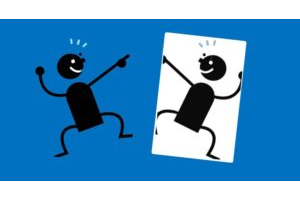Do you want to greatly improve your presentations?
I could just say, “hire me,” but you can improve your presentations all on your own, too. You can self-evaluate.
A good self-evaluation is a journey of awareness. A great self-evaluation is one that starts with preparation and planning well before you give your speech.
To prepare you need to have the equipment to record. You can buy an inexpensive video recorder and a tripod or buy just a voice recorder. Most phones have a recording feature (video and/or audio). If you want to be unobtrusive in your recording, just do the audio.
Additionally, plan one or two specific goals for speaker improvement that you will work on during the speech. Record and evaluate yourself practicing. Record your live presentation and evaluate that, too.
Watch or listen to yourself at least once, but 3 times or 4 times will allow you to evaluate at a deeper level.
Speech Self-Evaluation Checklist
1st viewing/listening: The first time is partly to recover from the shock of hearing or seeing yourself!
__overall effect,
__audience response
__anything that particularly stands out, positive or negative.
__How did you do on the one or two specific goals you had set?
__Did your speech fit the audience and context of the event? (e.g. speeches to teenagers in a high school classroom would typically emphasize different things, and be delivered differently than speeches to senior citizens on a cruise ship)
2nd listening: The second time just listen (turn off the visual), focusing on content, making an outline as you listen:
__Did you get the audience’s attention at the start? And, was your “attention-getter” relevant to the topic?
__Did your introduction clearly give your audience both a reason to listen, and a clear direction (a clear thesis)?
__Could you outline your own speech (was the organization easy to follow)?
__Did you support your points with examples, stories, statistics, metaphors, analogies?
__Did the transitions maintain flow?
__Did you ramble?
__During the speech did you connect with head (logic), heart (emotion), hand (action) and leave your audience with something to think, feel or do?
__Did you end powerfully? Did you call back your key points? Did your ending provide a feeling of closure? Did you have a call to action?
3rd listening: The third time, again just listen, focusing on voice (turn off the visual):
__Did you vary your vocal pace, pitch and volume in a way that enforced your message and kept it engaging?
__Do you need to project more?
__How was your use of language?
__Appropriate to audience?
__No jargon or slang that the audience wouldn’t relate to
__Good enunciation and correct pronunciation and grammar
__Little to no filler words (use of Ahs, Ums)
__Did you use rhetorical devices (e.g. simile, contrast, rhyme, alliteration, metaphor, rule of 3)
__Did you pause long enough after important points or rhetorical questions or after you said something funny (did you let people have the time to laugh or did you “step-on” the laughs)?
4th viewing: The fourth time, If you have video, watch the video again, leaving on the audio, but focusing on the visual:
__How was your eye contact?
__Did you speak from memorable key words or did you look down at wordy notes too much?
__Did you use sustained eye contact for entire thoughts? Or, did you flit or scan?
__Did your facial expressions, body language (stance, movement) and gestures distract from or enforce the message?
__Did your gestures look natural?
__Was your attire appropriate? Video, especially, makes you reconsider busy prints!
__ Did you move on purpose mostly (or was there noticeable pacing, rocking, hand-wringing, etc.)?
__If you used visual aids, were they easy to see and integrated smoothly?
A wrap up question:
If you had the opportunity to deliver this speech again next week, what are the top 1-3 changes that you would make?
Self-evaluation and recordings can also be shared with another speaking professional or a presentation coach.
Self-evaluate for more powerful presentations!

